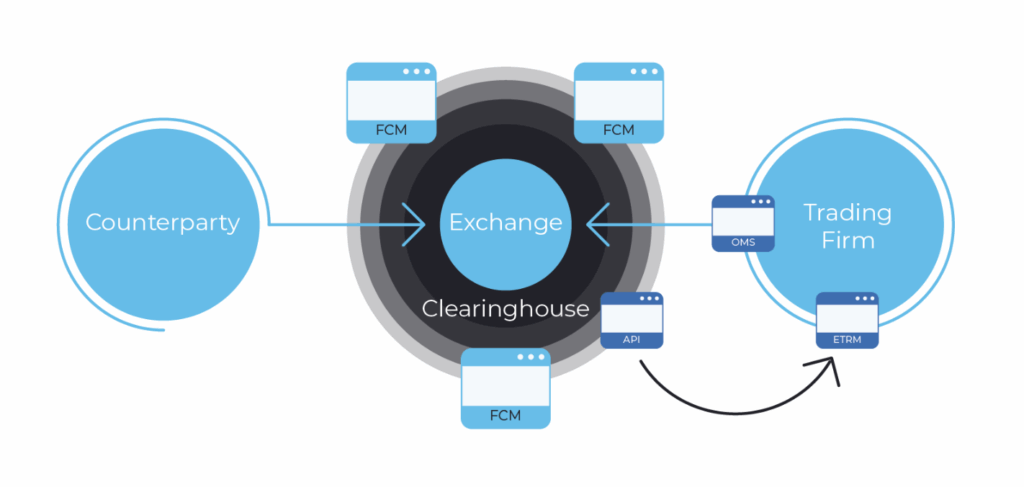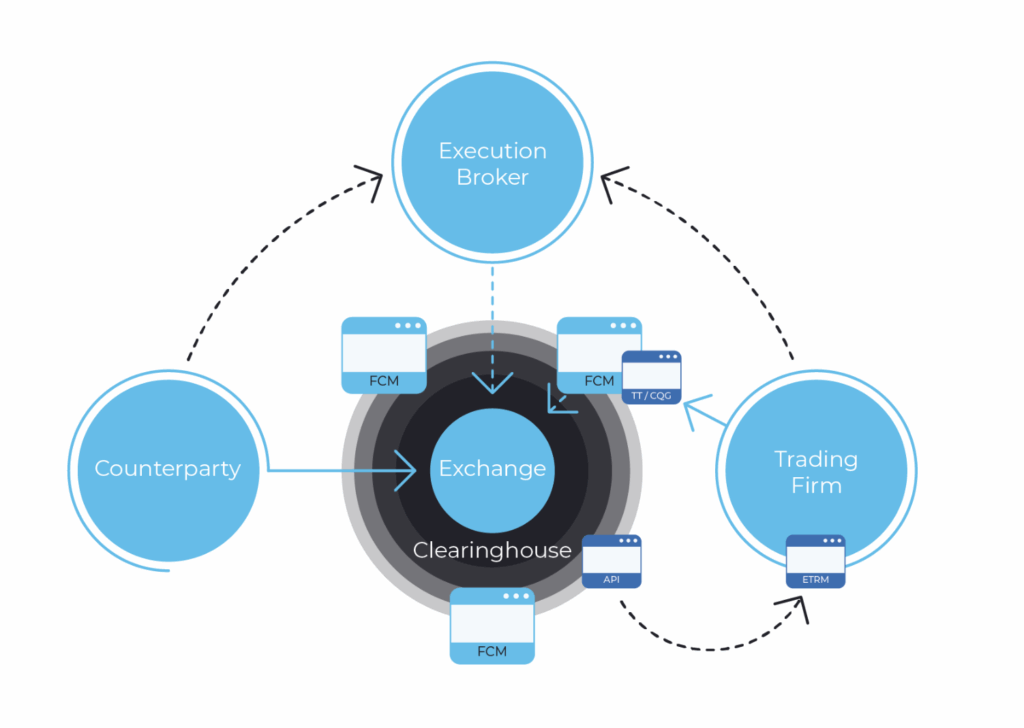In this second post in our series on the futures and options trading environment, we look at how to track ICE trade capture as data flows from a trader's buy/sell clicks through multiple systems before reaching your risk management platform. This journey involves exchanges, clearinghouses, futures commission merchants (FCMs), the trader's clearing account, and the ICE Trade Capture API - each playing a critical role in the trade data supply chain.
The typical ICE trade capture flow begins when a trader executes a buy/sell order through an Order Management System. The order reaches the exchange matching engine, where the trade moves to the clearinghouse for risk validation. Next, the clearing broker (FCM) processes the account and margin requirements before trade data flows through the ICE Trade Capture API and finally arrives at the trading firm’s risk system. This entire trade data supply chain operates in milliseconds when properly configured. However, small configuration errors can cause significant delays or missing trade data.
You can review Part 1 ‘Where are my ICE trades’ for the distilled checklist on trade data automation, scalability, and regulatory compliance, no matter how you execute trades.
Trade data supply chain components
Order Management System (OMS) Trading software interface for executing orders on exchanges. Examples include WebICE, Trading Technologies (TT), and CQG.
Futures Exchange Marketplace for trading futures and options contracts. Major exchanges include ICE, CME, Nodal, EEX, Eurex, and Euronext.
Clearinghouse Central risk management entity that acts as shock absorber when market participants face financial stress.
Clearing Broker / Futures Commission Merchant (FCM) Entity that collects margin from participants on behalf of the clearinghouse. Examples include Mizuho, ABN AMRO, Wells Fargo, and JP Morgan.
ICE Trade Capture API (TC API) Technology interface delivering real-time trading activity feeds to participants.
Trading Risk Management System (ETRM/CTRM/TRM) Enterprise software managing complete trade lifecycle from execution through settlement.
Counterparty The opposite side of a trade – the buyer to your sell order or seller to your buy order.
How ICE trade data flows
Futures trading at enterprise firms differs fundamentally from retail stock trading. Traders typically use one system to execute trades (the OMS) and another system to value positions and manage risk (the ETRM/CTRM). These systems must exchange data quickly and accurately through a multi-layered trade data supply chain involving exchanges, brokers, clearing firms, and internal systems.
When a trader executes a trade but it does not show up in the risk system, blame typically shifts between teams. Traders blame the IT department. The IT team blames traders.
FCMs claim their configuration is correct. In reality, every component in the trade data supply chain must be properly configured.
The diagram below shows the futures trade data ecosystem and how trades flow from the trading firm through the OMS, to the exchange, through the clearinghouse and FCMs, via the API, and back to the firm’s ETRM system.

The trading firm places orders through their OMS (such as WebICE). The order reaches the exchange’s matching engine where it meets the counterparty’s opposite order and the trade is created. The trade moves to the clearinghouse at the center of the ecosystem for risk validation, working with multiple clearing brokers (FCMs) who manage accounts and margin requirements. Finally, trade data flows through the ICE Trade Capture API back to the trading firm’s ETRM/CTRM for position management.
Who manages what
The broker-executed trade flow below shows how execution brokers interact with the exchange and clearinghouse ecosystem. The broker executes trades at the top of the diagram, which then flow through the FCM layer and clearinghouse to eventually reach the trading firm’s ETRM via the API.
Exchange-Managed (everything before TC API) The exchange handles order matching, clearinghouse operations, FCM clearing account processing, and initial data routing under standardized exchange control.
Firm-Managed (TC API to internal systems) From the ICE Trade Capture API onward, trading firms manage their own technology infrastructure, API connectivity, data normalization, multi-exchange data aggregation, and system integration. This varies significantly by organization and requires dedicated technology resources.

Common ICE Trade Capture problems
Problems in ICE trade capture typically arise from three key areas: the Order Management System, the Futures Commission Merchant configuration, or the technology integration layer. Understanding these common issues helps firms troubleshoot missing or delayed trade data.
1. OMS configuration and trade attribution
The Order Management System connects to exchanges and transmits orders. Traders may use WebICE or third-party platforms like Trading Technologies (TT) or CQG, often provided by their FCM. While these tools enable multi-market trading from a single interface, they introduce configuration complexities. When using an FCM-provided OMS, trades often execute under the FCM’s name rather than the trading firm’s name. The FCM must later allocate these trades back, creating potential data mismatches in the trade data supply chain.
To resolve this, ensure exchange sessions are established in your firm’s name, not the FCM’s name. This configuration step is critical for proper ICE trade capture, data attribution, and compliance documentation. Firms should establish sessions in their firm’s name, verify proper trade attribution flows, and maintain clear audit trails.
2. FCM Setup and Trade Allocation
The Futures Commission Merchant sits between the exchange, clearinghouse, and your trading firm, managing clearing accounts and controlling trade data routing. When an FCM hosts your OMS, you must configure it so trades flow directly to your clearing account and then through the ICE Trade Capture API. Improper configuration causes trades to disappear or appear under incorrect accounts.
Brokers help traders find liquidity or execute large block trades by executing in their own name, then “giving up” or allocating trades to the trader’s clearing account. To automate this, request your FCM to enable allocations in the ICE Credit system for every combination of broker, legal entity, and clearing account. Without this enablement, broker trades will not flow through the ICE Trade Capture API automatically.
Enable allocations for all broker/entity/account combinations, configure direct data routing to your clearing accounts, and test allocation flows regularly to ensure broker-executed trades flow smoothly through the trade data supply chain.
3. Software and API Integration
Once trades reach the ICE Trade Capture API, software takes over to feed data into your firm’s risk management system. This technology layer is entirely firm-managed and represents the most common source of trade data supply chain breakdowns. Software must explicitly request allocation messages when connecting to the ICE Trade Capture API—this requires specific API parameter configuration. Additionally, software must handle large volumes of allocation data efficiently. Each allocation includes multiple workflow steps (execution, review, approval).
Your integration software must intelligently filter and process this data for audit trail compliance. Broker-allocated trades arrive in different formats than regular listed trades.
Integration software must reformat allocation data to match standard trade message structures before loading into risk systems. These technical adjustments require significant time and development effort, there is no shortcut.
Implement robust API connection management, build comprehensive data normalization logic, handle high-volume allocation message processing, and maintain detailed error logging and monitoring.
These technical capabilities form the foundation for reliable, automated ICE trade capture that scales with your trading operations. Without proper software integration, traders must enter trades manually into risk systems. Despite advances in trading technology, manual trade entry remains surprisingly common across the industry, introducing errors, delays, and compliance risks.
Hassle free trade flow
Gain complete visibility across all your ICE trades and beyond. BroadPeak Trade Capture delivers real-time, unified trade data from ICE, CME, Nodal, and other exchanges directly to your E/CTRM, risk and analytics platforms. Built specifically for energy and commodity trading firms, BroadPeak provides direct exchange connectivity including full ICE Trade Capture API integration, intelligent automation for all trade types, clean structured normalized data, and faster access to reliable insights.
BroadPeak’s ETL capabilities handle diverse data formats and deliver clean, near real-time flows directly from over 100 exchanges, brokers, and execution platforms like Trayport and Trading Technologies. Our low-code, off-the-shelf adapters ensure clean, real-time data flow with minimal coding required.
Learn more about BroadPeak Trade Capture →







